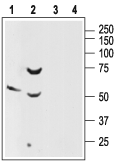Overview
- Peptide (C)GSNQTEPYYDMTSN, corresponding to amino acid residues 30-43 of rat SSTR2 (Accession P30680). Extracellular, N-terminus.
- Rat brain and pancreas lysates (1:200-1:500).
 Western blot analysis of rat brain (lanes 1 and 3) and pancreas (lanes 2 and 4) lysates:1-2. Anti-Somatostatin Receptor Type 2 (extracellular) Antibody (#ASR-006), (1:200).
Western blot analysis of rat brain (lanes 1 and 3) and pancreas (lanes 2 and 4) lysates:1-2. Anti-Somatostatin Receptor Type 2 (extracellular) Antibody (#ASR-006), (1:200).
3-4. Anti-Somatostatin Receptor Type 2 (extracellular) Antibody, preincubated with Somatostatin Receptor Type 2 (extracellular) Blocking Peptide (#BLP-SR006).
- Mouse cortex frozen sections and rat hippocampus frozen sections.
- Human colorectal adenocarcinoma (HT-29) cells (1:50).
Somatostatin is a small cyclic peptide that is widely expressed throughout the central nervous system and peripheral tissues.1 In peripheral tissues, somatostatin exerts inhibitory effects on secretion processes, whereas in the brain, it acts as a neurotransmitter in both a stimulatory and an inhibitory manner.1,2
Somatostatin mediates its action via six high affinity G-protein coupled receptors (SSTR1, SSTR2a, SSTR2b, SSTR3, SSTR4, and SSTR5), which are encoded by five genes.1,2 Expression of the different receptors is developmentally regulated in a time- and tissue-specific manner.2
Somatostatin receptors have been found on a variety of neuroendocrine tumors, such as paragangliomas, carcinoids, and breast tumors.3 Synthetic peptide derivatives of somatostatin have been successfully used in the treatment of neuroendocrine malignancies and in vivo imaging of tumors that are positive for somatostatin receptors.4
In general, SSTR2 is the most common SSTR subtype found in human tumors, followed by SSTR1, with SSTR3 and SSTR4 being less common.
